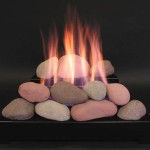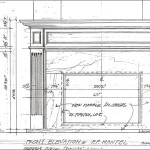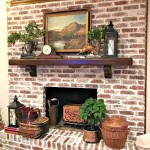Antique Wood Fireplace Mantels And Surrounds: A Timeless Elegance
Antique wood fireplace mantels and surrounds are architectural elements that instantly infuse a space with character, history, and warmth. These pieces, often crafted from hardwoods using techniques no longer commonly practiced, serve as focal points, transforming ordinary rooms into spaces of refined elegance. Their value extends beyond pure aesthetics, representing a connection to the past and offering a tangible link to previous generations of craftsmanship and design sensibilities. Understanding the nuances of these antique pieces, from their historical context to the types of wood used and the potential challenges of incorporation into a modern home, is essential for anyone considering acquiring one.
The term "mantel" refers to the shelf above the fireplace opening, although the entire ensemble surrounding the firebox is typically referred to as the fireplace surround. This surround often includes the mantel shelf, decorative pilasters or columns, a frieze (a decorative band beneath the mantel shelf), and a hearth, which is the floor area directly in front of the fireplace. Antique examples can be incredibly diverse, reflecting the varied styles of architecture and interior design that have prevailed over the centuries.
Historical Context and Styles of Antique Wood Fireplace Mantels
The history of fireplace mantels mirrors the evolution of domestic heating and architectural trends. Early fireplaces, primarily functional necessities for warmth and cooking, gradually evolved into decorative elements. Medieval fireplaces were often simple stone structures, but as houses became more sophisticated, so did their fireplaces. By the 17th and 18th centuries, wood mantels began to gain prominence, reflecting the increasing availability of lumber and the growing importance of the fireplace as a central feature of the home. These early mantels were often heavy and ornate, reflecting the Baroque and Rococo styles prevalent at the time.
The Georgian era (1714-1830) saw a shift towards more classical designs, influenced by the rediscovery of ancient Greek and Roman architecture. Georgian mantels are characterized by their balanced proportions, symmetrical designs, and the use of classical motifs such as dentil molding, fluted columns, and carved swags. Common wood types included pine, oak, and mahogany. These mantels were often painted in light colors, reflecting the era's preference for airy and bright interiors.
The Victorian era (1837-1901) brought a resurgence of ornamentation and eclecticism. Victorian mantels are known for their elaborate carvings, intricate details, and the use of darker woods like walnut and cherry. They often incorporate elements from various historical styles, reflecting the Victorian era's fascination with history and its willingness to blend different design traditions. Mass production techniques also began to influence mantel design, making more ornate styles accessible to a wider range of homeowners.
The early 20th century saw the rise of the Arts and Crafts movement, which championed handmade craftsmanship and natural materials. Arts and Crafts mantels are typically simpler in design than Victorian examples, emphasizing clean lines, natural wood finishes, and the use of materials like oak and maple. These mantels often feature subtle carvings and geometric patterns, reflecting the movement's emphasis on functionality and honest design. The Art Deco era that followed introduced streamlined forms and geometric motifs, occasionally seen incorporated into fireplace mantel designs.
Identifying and Assessing Antique Wood Fireplace Mantels
Authenticating and assessing antique mantels requires a keen eye and some knowledge of historical styles and construction techniques. Several factors contribute to a mantel's value and desirability, including its age, style, condition, rarity, and provenance (its history of ownership). Start by carefully examining the mantel for any identifying marks or labels. Some manufacturers marked their products with stamps, labels, or even small metal plaques. These markings can provide valuable information about the mantel's origin and age.
Pay close attention to the wood species. Different wood types were favored during different periods, and this can help narrow down the mantel's age and origin. Pine was a common choice for painted mantels, while hardwoods like oak, walnut, cherry, and mahogany were often used for more formal designs. The type of joinery used is another important clue. Hand-cut dovetails, mortise-and-tenon joints, and other traditional woodworking techniques indicate a pre-industrial origin. Machine-cut joints, on the other hand, suggest a later date.
Carefully assess the mantel's condition. Look for signs of damage, such as cracks, warping, rot, or insect infestation. Minor imperfections are to be expected in antique pieces, but significant damage can detract from their value and structural integrity. Check for any repairs or alterations that may have been made over the years. While some repairs are acceptable, extensive alterations can compromise the mantel's historical accuracy and value. The presence of original hardware, such as hinges, latches, and decorative elements, can also enhance the mantel's appeal.
Finally, consider the mantel's style and design. Does it reflect a specific historical period or architectural style? Is it a rare example of a particular design? The more unique and well-preserved the mantel, the more valuable it is likely to be. Consulting with an antique expert or appraiser can provide valuable insights and help determine the mantel's true value. Researching comparable examples that have sold at auction or through reputable dealers can also help establish a fair market price.
Integrating Antique Mantels Into Modern Homes
Incorporating an antique fireplace mantel into a modern home requires careful planning and consideration to ensure that it complements the existing architecture and design. The scale and proportions of the mantel are crucial. A mantel that is too large or too small for the space will look out of place. Measure the dimensions of the fireplace opening and the surrounding wall area to determine the appropriate size for the mantel. Consider the ceiling height and the overall scale of the room when making your selection. A high-ceilinged room can accommodate a larger, more ornate mantel, while a smaller room may benefit from a simpler, more streamlined design.
The style of the mantel should also complement the overall aesthetic of the home. A Victorian mantel, with its elaborate carvings and dark wood finish, may not be the best choice for a minimalist, modern space. Conversely, a sleek, modern mantel may look out of place in a traditional, period home. Aim for a cohesive look that blends the old and the new in a harmonious way. Consider painting or refinishing the mantel to better match the color palette and style of your home. A fresh coat of paint can brighten up an older mantel and give it a more contemporary feel. However, be mindful of preserving the mantel's original character and avoiding irreversible alterations that could detract from its value.
Ensure that the mantel is properly installed for safety and stability. It is recommended to hire a qualified professional to install the mantel, especially if it is heavy or complex. The mantel should be securely attached to the wall using appropriate hardware and techniques. Ensure that the mantel meets all local building codes and safety regulations. If you plan to use the fireplace, have it inspected by a qualified professional to ensure that it is in good working order and that the mantel is properly positioned to prevent overheating or fire hazards. Consider adding a fire screen to protect the mantel from sparks and embers.
When integrating an antique mantel into a modern home, the surrounding décor can significantly impact its overall impact. Consider using complementary colors, textures, and materials to create a cohesive and visually appealing space. A neutral color palette can help the mantel stand out as a focal point, while carefully chosen accessories can enhance its character and style. Incorporate antique or vintage items that complement the mantel's era and design. A vintage mirror, a set of antique candlesticks, or a collection of old books can add a touch of history and charm to the space.
Alternatively, create a striking contrast by pairing the antique mantel with modern furniture and artwork. A sleek, contemporary sofa or a bold, abstract painting can create an unexpected and visually interesting juxtaposition. The key is to find a balance between the old and the new, creating a space that feels both timeless and modern. Lighting can also play a significant role in highlighting the mantel's details and creating a warm and inviting atmosphere. Install recessed lighting to accent the mantel's architectural features or use sconces or table lamps to create a soft, ambient glow.
Careful consideration should be given to the hearth material. If the original hearth is missing or damaged, select a replacement that complements the mantel's style and the overall design of the room. Marble, slate, and stone are all popular choices for hearths, each offering a unique aesthetic. Consider the texture and color of the hearth material to ensure that it blends seamlessly with the mantel and the surrounding décor. Ultimately, integrating an antique fireplace mantel into a modern home is about creating a space that reflects your personal style and appreciation for history. With careful planning and attention to detail, you can create a truly unique and beautiful space that will be enjoyed for years to come.

Restoration Resources New England S Primary Source For Authentic Architectural Antiques Wood Mantels Section

Rustic Charm Full Surround Fireplace Mantel Antique Wood Beam Bespoke Sizing Color Selection With Legs Real

Antique Combed Stained Fireplace Mantel With Insert And Hearth Surrounds

Antique Jacobean Gothic Fireplaces Westland London

Old House Parts Company Architectural Salvage Antique Windows And Doors Hardware For Interior Exterior Home Improvement

Antique Pine Wood Fireplace Mantel Surround With Dark Grain Ga9005 Governor S Architectural Antiques

Old House Parts Company Architectural Salvage Antique Windows And Doors Hardware For Interior Exterior Home Improvement

Pin On Fireplace

Antique Mantels Surrounds Accessories For

Aesthetic Movement Antique Wood Fireplace Westland Antiques








